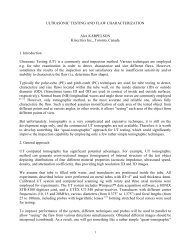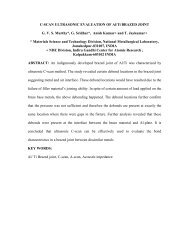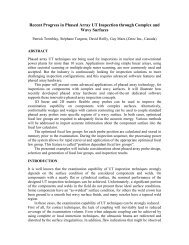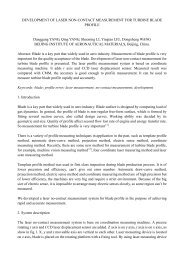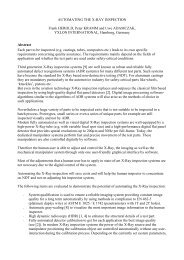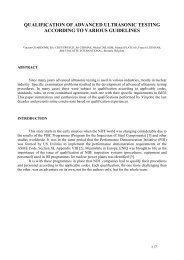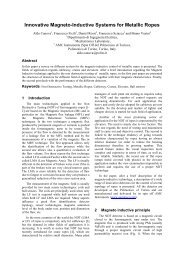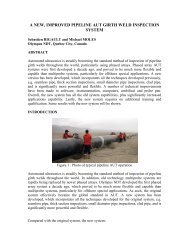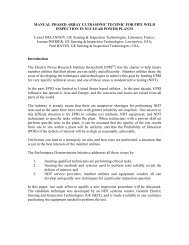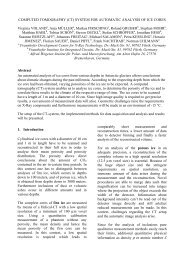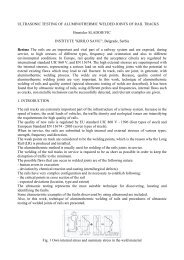Phased Array Ultrasonic Tube Testing ECNDT Moscow June 2010 ...
Phased Array Ultrasonic Tube Testing ECNDT Moscow June 2010 ...
Phased Array Ultrasonic Tube Testing ECNDT Moscow June 2010 ...
You also want an ePaper? Increase the reach of your titles
YUMPU automatically turns print PDFs into web optimized ePapers that Google loves.
<strong>Phased</strong> <strong>Array</strong> <strong>Ultrasonic</strong> <strong>Tube</strong> <strong>Testing</strong><br />
<strong>ECNDT</strong> <strong>Moscow</strong> <strong>June</strong> <strong>2010</strong><br />
DIN EN ISO 9001:2000<br />
<strong>Phased</strong> <strong>Array</strong> <strong>Ultrasonic</strong> <strong>Testing</strong> of Heavy-Wall Seamless <strong>Tube</strong>s by Means of<br />
a <strong>Testing</strong> Portal<br />
Authors:<br />
Dr. (USA) Wolfram A. Karl Deutsch, Michael Joswig, Klaus Maxam c/o KARL DEUTSCH Prüf- und Messgerätebau<br />
GmbH + Co KG, Wuppertal, Germany<br />
Stefan Nitsche c/o VALLOUREC & MANNESMANN TUBES Düsseldorf, Michel Vahe c/o VALLOUREC &<br />
MANNESMANN TUBES Aulnoye<br />
Alexandre Noël c/o VRA (Vallourec Research Aulnoye), France<br />
Patrick Pichard, Sylvain Deutsch c/o M2M <strong>Phased</strong> <strong>Array</strong> Technologies, Les Ulis near Paris, France<br />
Summary<br />
An ultrasonic testing portal for heavy-wall seamless tubes within a diameter range from 178 – 419 mm, a wall<br />
thickness range from 20 – 100 mm and a tube length from 4 – 15 m is presented in this article. During the<br />
inspection, the tube is scanned with helical testing traces. While the tube is rotating, the probes are linearly guided<br />
along its longitudinal axis and coupled onto the tube surface in the 12 o’clock position. Special about the testing<br />
system is the way to couple the ultrasound into the tube. Water jet coupling (also called squirter technique) is used,<br />
which means that the water path between probe and tube surface is in the order of several centimetres.<br />
In total, five probes holders are used. Four probe holders contain the probes for longitudinal and transverse defects<br />
and one probe holder is for straight-beam testing to measure the wall thickness and to detect laminations. All<br />
probes are phased array probes. <strong>Phased</strong> arrays allow a convenient electronic adjustment of the ultrasonic<br />
incidence angle. Therefore, optimal angles can be chosen for the detection of internal and external longitudinal<br />
defects – especially important for heavy-wall tubes. For the detection of transverse defects, phased array probes<br />
are used which can produce overlapping sound beams. Thus, a high reliability in detection is achieved and the<br />
amplitude deviation in dynamic mode is reduced.<br />
The probe holders are gimbal mounted and are flexibly guided along the tube surface. The guiding elements<br />
(rollers made of hardened steel) do not have to be changed for varying tube diameter due to the jet coupling<br />
technique. This results in short change-over times and a long-lasting mechanical set-up.<br />
A modern phased array testing electronics with 192 parallel testing channels is used.<br />
<strong>Ultrasonic</strong> Coupling Techniques<br />
Since air is a poor conductor for ultrasound, water is used for the ultrasonic coupling in most industrial<br />
applications. This influences the design of every testing system. The principal ways to couple ultrasound into the<br />
tube are discussed below.<br />
Immersion testing is a very common method for smaller specimens being inspected piece by piece, e.g.<br />
automotive components. For an on-line inspection of tubes with diameters up to 170 mm, a specially designed<br />
immersion chamber can be used (patented HRP-setup). Only a short section of the tube is then immersed.<br />
For larger pipe diameters the growing ovalities require a probe guidance on the pipe surface and therefore other<br />
coupling concepts. Two coupling methods are mostly encountered in industrial applications. One technique is<br />
commonly called water gap coupling. The probe is mounted into a probe holder and the distance of the probe<br />
face to the pipe surface is in the order of 0.3 mm. Vibrations during the testing process endanger a stable coupling<br />
and also the wear of the guiding shoes and the ultrasonic probes are disadvantages of this technique.<br />
Water jet coupling (also called squirter technique) has been used by KARL DEUTSCH since the 1970’s and is an<br />
elegant method to avoid the above mentioned problems. Water jet coupling produces stable coupling conditions<br />
and yields a longer lifetime of the probes. A water jet (column) is guided within a plastic nozzle towards the tube<br />
surface. The jet diameter has to be large enough to carry the entire ultrasonic beam and has to be without air<br />
bubbles and turbulences for a good ultrasonic signal-to-noise ratio. A fairly long water column (in this case 50 –<br />
150 mm) between probe and tube guides the ultrasound. This technique is almost free of wear. Only the shoes or<br />
rollers which guide the probe holder along the pipe surface have to be changed from time to time but in general,<br />
1_03_27.doc 08.Feb-<strong>2010</strong><br />
KARL DEUTSCH Prüf- und Messgerätebau GmbH + Co KG • Otto-Hausmann-Ring 101 • D-42115 Wuppertal • Tel. (+49 -202) 71 92 - 0 • Fax (+49 -202) 71 49 32 • e-mail: info@karldeutsch.de<br />
Seite 1 von 1
<strong>Phased</strong> <strong>Array</strong> <strong>Ultrasonic</strong> <strong>Tube</strong> <strong>Testing</strong><br />
<strong>ECNDT</strong> <strong>Moscow</strong> <strong>June</strong> <strong>2010</strong><br />
DIN EN ISO 9001:2000<br />
they don’t have to be changed for different pipe curvatures (diameters). Relative speeds between tube surface and<br />
ultrasonic probe of up to 2 m/sec are possible.<br />
Since phased array probes often have larger sizes than conventional probes and due to their electronic beam<br />
steering capabilities, the water jet diameter is even larger than for conventional testing machines. Due to the large<br />
wall thickness of the tubes (and to avoid ghost echoes within the testing range), the length of the water column was<br />
up to 150 mm. The design of the respective water nozzles and probe holders was a challenge for the current<br />
project.<br />
Figure Coupling Techniques. a) immersion testing for high-speed online testing, b) partial immersion testing,<br />
c) gap coupling with narrow water film between probe and tube surface, and d) water jet coupling (squirter setup).<br />
<strong>Ultrasonic</strong> <strong>Testing</strong> Concepts for <strong>Tube</strong>s<br />
<strong>Tube</strong>s in the diameter range from 10 up to 170 mm can be inspected with the ECHOGRAPH-HRP.R system. The<br />
biggest advantage of this system is the high through-put rate of up to 2 m/s which is achieved by avoiding any<br />
mechanical rotation and by a linear feeding of the tubes. The circumference of the tube is surrounded by stationary<br />
probes. The number of probes is sufficient to produce overlapping sound fields for full coverage. A precise<br />
evaluation of the flaw length is much more reliable than with any rotational system since the defect is always<br />
detected by the same probe with several ultrasonic shots. Also, the detection of short defects is a strong point of<br />
such a system with stationary probes.<br />
Larger tubes diameters (typical up to 610 mm) can be inspected in partial immersion with the ECHOGRAPH-<br />
RPS.R testing system. Water-filled test chambers are located underneath the tubes and hold several probe<br />
batteries. While the probes remain fixed, the pipes move along the test chambers with a helical motion. This<br />
method allows for coupling of large probes – so a good pre-requisite for phased array inspection. A disadvantage is<br />
the complex and rather expensive tube conveyor where rotational and linear tube feeding must work without<br />
slippage. Secondly, the maintenance of such a system requires special attention: Loose scale and dirt on the tube<br />
surface is collected in the water tanks.<br />
Figure <strong>Tube</strong> <strong>Testing</strong> Concepts. a) high-speed online test, b) tube testing in partial immersion, and c) tube testing<br />
by means of a testing portal and squirter coupling.<br />
1_03_27.doc 08.Feb-<strong>2010</strong><br />
KARL DEUTSCH Prüf- und Messgerätebau GmbH + Co KG • Otto-Hausmann-Ring 101 • D-42115 Wuppertal • Tel. (+49 -202) 71 92 - 0 • Fax (+49 -202) 71 49 32 • e-mail: info@karldeutsch.de<br />
Seite 2 von 2
<strong>Phased</strong> <strong>Array</strong> <strong>Ultrasonic</strong> <strong>Tube</strong> <strong>Testing</strong><br />
<strong>ECNDT</strong> <strong>Moscow</strong> <strong>June</strong> <strong>2010</strong><br />
DIN EN ISO 9001:2000<br />
The third considered system type is the ECHOGRAPH-RPT.R. This system type is especially suitable for an off-line<br />
inspection. It consists of a testing portal and several probe holders. The tubes are typically loaded with a conveyor<br />
system. Once the tubes are placed into the testing portal, rollers put the tubes into rotation. The number of probe<br />
holders is chosen in accordance with the desired through-put. They are linearly moved along the tube and inspect<br />
the tube in the 12 o’clock position. The rotating tube and the linear probe movements result in helical test traces.<br />
The coupling is achieved with guided water jets (squirter technique), which offers many advantages as already<br />
discussed. For large ultrasonic probes and heavy tube walls (i.e. long water columns), the generation of the laminar<br />
water jets is a challenging task.<br />
Detection of Longitudinal Defects<br />
This testing task is of highest importance for most tubes due to the manufacturing process. The difficulty for heavywalled<br />
tubes is the choice of the optimal testing angle. By means of phased arrays, the required testing angle can<br />
be electronically chosen without any changes to the mechanical setup. Also for a diameter change of the tube, the<br />
testing system only needs a new set of electronic testing parameters. The mechanical probes positions and the<br />
guiding elements remain unchanged. A 2 MHz linear array probe was chosen for the application. The helical feed<br />
per probe and revolution was approx. 10 mm. Four similar arrays were then used for a higher throughput. The<br />
same concept is carried out in both circumferential tube directions (clockwise, counter-clockwise).<br />
Figure Principle of Longitudinal Defect Detection. Three possible sounds paths are shown (not to scale).<br />
a) direct insonification of internal defect, b) direct insonification of external defect, c) insonification of external defect<br />
with full skip.<br />
Detection of Transverse Defects<br />
A 4 MHz linear array probe was chosen for the detection of transverse defects. For a rotational setup, the detection<br />
of transverse defects is a challenging task, because of the high relative speed between probe and defect.<br />
Therefore, overlapping sound beams are produced in separate testing functions. This means that only part of the<br />
array is active during one shot. During the next shot, the sound beam is moved by using other elements within the<br />
same array. The helical feed per probe and revolution was approx. 10 mm. Four similar arrays were then used for a<br />
higher throughput. The same concept is carried out in both tube axis directions.<br />
1_03_27.doc 08.Feb-<strong>2010</strong><br />
KARL DEUTSCH Prüf- und Messgerätebau GmbH + Co KG • Otto-Hausmann-Ring 101 • D-42115 Wuppertal • Tel. (+49 -202) 71 92 - 0 • Fax (+49 -202) 71 49 32 • e-mail: info@karldeutsch.de<br />
Seite 3 von 3
<strong>Phased</strong> <strong>Array</strong> <strong>Ultrasonic</strong> <strong>Tube</strong> <strong>Testing</strong><br />
<strong>ECNDT</strong> <strong>Moscow</strong> <strong>June</strong> <strong>2010</strong><br />
DIN EN ISO 9001:2000<br />
Figure Principle of Transverse Defect Detection. Two main sounds paths are shown (not to scale) which are<br />
produced from different groups within the array probe. The corresponding sound columns have sufficient diameter<br />
for overlap.<br />
Wall Thickness Measurement and Lamination Detection<br />
A 4 MHz linear array probe with 32 elements was chosen for this testing task. The length of the array and therefore<br />
the helical feeding of the system was approx. 50 mm. The ultrasonic coupling of such a long probe by means of a<br />
squirter setup was a difficult task. The capability of a phased array to separately focus in transmission and<br />
reception mode was also crucial. The measurement of a wall thickness and the detection of small inclusions require<br />
different operation (focussing) modes of the same array. Also, the respective wall thickness strongly influences the<br />
required testing parameters (focal depths).<br />
The ultrasonic data for the straight-beam testing was used to compute a C-scan image for the entire tube wall.<br />
Laminations and wall thickness variations can clearly be seen in the colour-coded image (green ok, red not ok).<br />
Figure Principle of Wall Thickness Measurement and Lamination Detection. Two main sounds paths are<br />
shown (not to scale) to measure the wall thickness and to detect laminations in the mid wall.<br />
1_03_27.doc 08.Feb-<strong>2010</strong><br />
KARL DEUTSCH Prüf- und Messgerätebau GmbH + Co KG • Otto-Hausmann-Ring 101 • D-42115 Wuppertal • Tel. (+49 -202) 71 92 - 0 • Fax (+49 -202) 71 49 32 • e-mail: info@karldeutsch.de<br />
Seite 4 von 4
<strong>Phased</strong> <strong>Array</strong> <strong>Ultrasonic</strong> <strong>Tube</strong> <strong>Testing</strong><br />
<strong>ECNDT</strong> <strong>Moscow</strong> <strong>June</strong> <strong>2010</strong><br />
DIN EN ISO 9001:2000<br />
Probe Configuration<br />
In order to produce a throughput in accordance with the customer requirements, five probes holders were<br />
employed. Four similar probe holders for the detection of longitudinal and transverse defects with a total helical<br />
feed of approx. 40 – 50 mm and one paintbrush-probe holder for straight-beam testing were mounted to the testing<br />
portal.<br />
Figure Sound Beams. Angle beam testing for longitudinal and transverse defect detection (left) and straight-beam<br />
testing for wall thickness measurement and lamination detection (right).<br />
Figure Probe Holders. Five probe holders for different testing tasks, A = calibration tube, B = probe holders for<br />
longitudinal and transverse defects, C = probe holder for wall thickness, and D = paint marking (true to position).<br />
1_03_27.doc 08.Feb-<strong>2010</strong><br />
KARL DEUTSCH Prüf- und Messgerätebau GmbH + Co KG • Otto-Hausmann-Ring 101 • D-42115 Wuppertal • Tel. (+49 -202) 71 92 - 0 • Fax (+49 -202) 71 49 32 • e-mail: info@karldeutsch.de<br />
Seite 5 von 5
<strong>Phased</strong> <strong>Array</strong> <strong>Ultrasonic</strong> <strong>Tube</strong> <strong>Testing</strong><br />
<strong>ECNDT</strong> <strong>Moscow</strong> <strong>June</strong> <strong>2010</strong><br />
DIN EN ISO 9001:2000<br />
Figure Probe Configuration. Five probe holders for different testing tasks, L = longitudinal defects, T = transverse<br />
defects and W = wall thickness measurement (and lamination detection).<br />
<strong>Testing</strong> Mechanics ECHOGRAPH-RPT.R<br />
The testing mechanics was completely designed and assembled in-house in the systems workshop in Wuppertal,<br />
Germany and the machine was fully tested before shipment in order to reduce the installation period at the<br />
Vallourec-Mannesmann plant. The total length of the machine is approx. 25 m. One short tube segment and one<br />
longer sample tube can be seen on the photograph. Artificial defects were machined into both tubes. The short<br />
tube segments are used for the dynamic system calibration. Their length is 700 mm which is sufficient to verify the<br />
testing sensitivity with full helical feeding of the machine. Afterwards, the defects in the long tube were used to<br />
verify the system settings.<br />
The pipe transportation, the calibration stand and the tube samples were supplied by the Vallourec-Mannesmann<br />
plant in Aulnoye.<br />
Figure <strong>Testing</strong> Mechanics. View of the testing machine in the systems workshop before shipment. A = testing<br />
electronics, B = probe holders, C = testing portal, D = calibration station, and E = production tube.<br />
1_03_27.doc 08.Feb-<strong>2010</strong><br />
KARL DEUTSCH Prüf- und Messgerätebau GmbH + Co KG • Otto-Hausmann-Ring 101 • D-42115 Wuppertal • Tel. (+49 -202) 71 92 - 0 • Fax (+49 -202) 71 49 32 • e-mail: info@karldeutsch.de<br />
Seite 6 von 6
<strong>Phased</strong> <strong>Array</strong> <strong>Ultrasonic</strong> <strong>Tube</strong> <strong>Testing</strong><br />
<strong>ECNDT</strong> <strong>Moscow</strong> <strong>June</strong> <strong>2010</strong><br />
DIN EN ISO 9001:2000<br />
Figure <strong>Testing</strong> Cycle. a) linear loading of tube, b) tube is put into rotation and approach of probe holders,<br />
c) rotational tube testing, and d) discharging of tube and backwards travelling of probe holders.<br />
<strong>Phased</strong> <strong>Array</strong> <strong>Testing</strong> Electronics<br />
The MultiX-Hardware is made up of analogue parts for the transmission and the reception of ultrasonic signals, and<br />
numerical parts to record elementary signals, and to sum them in accordance with the focal laws. The MultiX<br />
phased array hardware is based on a parallel architecture. All elements are connected to their own numerical<br />
channels for transmission and/or reception. The main components are 8-channels-boards connected to a single<br />
mother board. The mother board transfers the data of all 8-channels-boards to the PC or to other external devices.<br />
This architecture allows every channel combination with a real-time change of the focal laws. This is especially<br />
useful for the control of two-dimensional array transducers (matrix probes) if the focussing parameters are different<br />
in transmission and reception mode. The use of embedded processors (including two PowerPC’s) allows a great<br />
number of operations which can be flexibly programmed in order to meet specific requirements with high production<br />
rates.<br />
Figure <strong>Testing</strong> Electronics. <strong>Phased</strong> array electronics with a total of 192 channels. A = wall thickness testing<br />
electronics, B = angle beam testing electronics , C = probe connectors, D = industrial PC, and E = electrical<br />
connectors.<br />
1_03_27.doc 08.Feb-<strong>2010</strong><br />
KARL DEUTSCH Prüf- und Messgerätebau GmbH + Co KG • Otto-Hausmann-Ring 101 • D-42115 Wuppertal • Tel. (+49 -202) 71 92 - 0 • Fax (+49 -202) 71 49 32 • e-mail: info@karldeutsch.de<br />
Seite 7 von 7
<strong>Phased</strong> <strong>Array</strong> <strong>Ultrasonic</strong> <strong>Tube</strong> <strong>Testing</strong><br />
<strong>ECNDT</strong> <strong>Moscow</strong> <strong>June</strong> <strong>2010</strong><br />
DIN EN ISO 9001:2000<br />
The Multi2000-software provides high flexibility by taking into account various configurations of phased arrays<br />
ultrasonic testing. The software allows the calculation of focal laws by means of the CIVA simulation software and<br />
their transfer to the probe(s). The software controls all ultrasonic and acquisition parameters. It can be operated on<br />
standard computers or laptops depending on the user’s requirements. Remote control functions can be provided to<br />
drive the Multi2000-software and MultiX-hardware through Ethernet using TCP/IP protocol.<br />
A special strength of the underlying CIVA-software module is the intuitive setup of the probe configuration and the<br />
component position with respect to the phased array probe(s). Therefore, the computation of the focal laws and the<br />
corresponding sound beams can be visualized and checked for plausibility. Therefore, this software provides the<br />
theoretical ultrasonic performance before the corresponding probes are manufactured (number of elements,<br />
element pitch, testing frequency, bandwidth, focussing characteristics, etc.).<br />
Figure CIVA-software. <strong>Phased</strong> array probe and component setup by using the CIVA-software module.<br />
<strong>Ultrasonic</strong> Test Results<br />
As discussed earlier, the short tube segment carrying artificial defects was used for a dynamic system calibration.<br />
The calibration is carried out in two steps. First, the artificial defects must be detected by each probe and each<br />
testing function (e.g. internal and external defect) with a helical feed of 10 mm per revolution. Afterwards, the<br />
sensitivity of all test functions is equalized so that each test function and each phased array probe is working with<br />
the same sensitivity. Secondly, the sensitivity setting is checked by running the machine with the full helical feed of<br />
40 mm. After successfully finishing this procedure, the testing machine can be operated in automatic mode to<br />
check the production tubes.<br />
<strong>Ultrasonic</strong> data for a calibration tube with a diameter of 406 mm and a wall thickness of 28 mm is now presented.<br />
Four notches within the calibration tube had to be detected (longitudinal, transverse, internal, external) and each<br />
notch using two incidence directions (= 8 test functions). The ultrasonic amplitudes for all 8 test functions and 4<br />
probe holders show a successful calibration in form of an 8 by 4-matrix. The yellow cursors mark the range for the<br />
relevant ultrasonic data to be used for the automated sensitivity equalization. Therefore it can be avoided, that e.g.<br />
the large test defects for the wall thickness measurement have influence on the angle beam calibration.<br />
Figure Test <strong>Tube</strong>. (Provisional) calibration station with rotating device and calibration tube (406mm x 28mm).<br />
1_03_27.doc 08.Feb-<strong>2010</strong><br />
KARL DEUTSCH Prüf- und Messgerätebau GmbH + Co KG • Otto-Hausmann-Ring 101 • D-42115 Wuppertal • Tel. (+49 -202) 71 92 - 0 • Fax (+49 -202) 71 49 32 • e-mail: info@karldeutsch.de<br />
Seite 8 von 8
<strong>Phased</strong> <strong>Array</strong> <strong>Ultrasonic</strong> <strong>Tube</strong> <strong>Testing</strong><br />
<strong>ECNDT</strong> <strong>Moscow</strong> <strong>June</strong> <strong>2010</strong><br />
DIN EN ISO 9001:2000<br />
Figure Calibration. Eight rows with ultrasonic amplitudes from four notches, each detected from two incidence<br />
directions (i.e. a total of 8 testing functions). The four columns represent the four probe holders (i.e. a matrix of 8 by<br />
4 is produced).<br />
After carrying out the calibration, the ultrasonic parameters are verified with full testing speed. The interleafing test<br />
traces of the 4 probe holders are electronically shifted to produce the amplitude strip chart (ultrasonic amplitudes<br />
versus tube length). Each amplitude block represents 40 mm of tube length and shows the maximum amplitude of<br />
all ultrasonic signals within that tube length. Clearly, all four notches are detected from both incidence directions.<br />
Figure Calibration Check. Amplitude strip chart for 8 testing functions with full testing speed. All four notches are<br />
clearly detected from 2 incidence directions. The signals are the maximum amplitudes from all 4 probe holders.<br />
In order to make the calibration convenient for the user, the live A-scans of all eight angular testing functions are<br />
shown. In addition, the A-scan of the echo-echo-measurement for the straight-beam test (wall thickness) is<br />
presented. On a second monitor, the live representation of either the amplitude strip chart or the C-scan of the pipe<br />
wall is shown.<br />
1_03_27.doc 08.Feb-<strong>2010</strong><br />
KARL DEUTSCH Prüf- und Messgerätebau GmbH + Co KG • Otto-Hausmann-Ring 101 • D-42115 Wuppertal • Tel. (+49 -202) 71 92 - 0 • Fax (+49 -202) 71 49 32 • e-mail: info@karldeutsch.de<br />
Seite 9 von 9
<strong>Phased</strong> <strong>Array</strong> <strong>Ultrasonic</strong> <strong>Tube</strong> <strong>Testing</strong><br />
<strong>ECNDT</strong> <strong>Moscow</strong> <strong>June</strong> <strong>2010</strong><br />
DIN EN ISO 9001:2000<br />
Figure <strong>Ultrasonic</strong> Signal Visualization. The A-scans for the eight testing functions with angular sound<br />
transmission are shown on the left. The results for straight-beam testing (wall thickness measurement and<br />
lamination detection) are shown on the right.<br />
Literature<br />
[1] V. Deutsch, M. Platte, M. Vogt: <strong>Ultrasonic</strong> <strong>Testing</strong> – Principles and Industrial Applications (in German language),<br />
372 pages, Springer publishing house, 1997.<br />
[2] V. Deutsch, M. Platte, M. Vogt, W. A. K. Deutsch, V. Schuster: <strong>Ultrasonic</strong> <strong>Testing</strong> – Compact and<br />
Understandable, 77 pages, Castell publishing house, Wuppertal, 2002.<br />
[3] P. Möller: <strong>Ultrasonic</strong> Applications with Probe Carriers for Water Jet Coupling (in German language),<br />
Proceedings of the German NDT-conference, Garmisch, p. 109-117, 1993.<br />
[4] W. A. K. Deutsch: Automated <strong>Ultrasonic</strong> Inspection – Examples from the Steel Mill, WCNDT World Conference<br />
for Nondestructive <strong>Testing</strong>, Rome Italy, October 2000.<br />
[5] W. A. K. Deutsch, P. Schulte, M. Joswig, R. Kattwinkel: Automatic <strong>Ultrasonic</strong> Pipe Inspection, <strong>ECNDT</strong> European<br />
Conference for Nondestructive <strong>Testing</strong>, Berlin, September 2006.<br />
[6] L. Le Ber, O. Roy, N. Jazayeri: Applications of <strong>Phased</strong> <strong>Array</strong> Techniques to NDT of Industrial Structures,<br />
TINDT2008, 2008<br />
[7] L. Le Ber, O. Roy, P. Benoist: <strong>Ultrasonic</strong> <strong>Phased</strong> <strong>Array</strong> inspection modelling with CIVA, Modelling NDT, 2007.<br />
[8] P. Benoist, P. Calmon, S. Leberre, T. Sollier: CIVA, an integration software platform for the simulation and<br />
processing of NDT data, WCNDT 2004.<br />
1_03_27.doc 08.Feb-<strong>2010</strong><br />
KARL DEUTSCH Prüf- und Messgerätebau GmbH + Co KG • Otto-Hausmann-Ring 101 • D-42115 Wuppertal • Tel. (+49 -202) 71 92 - 0 • Fax (+49 -202) 71 49 32 • e-mail: info@karldeutsch.de<br />
Seite 10 von 10



